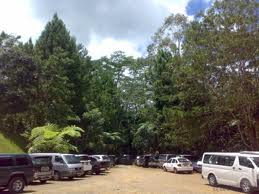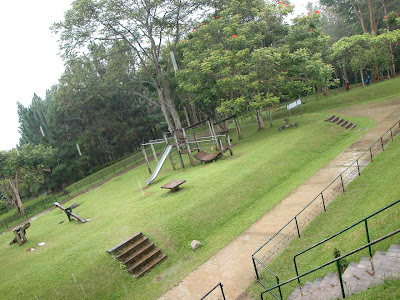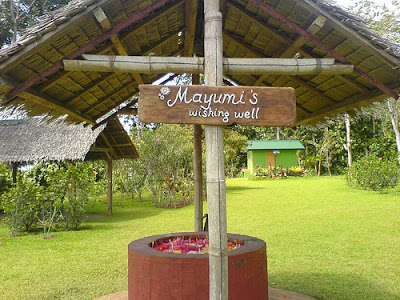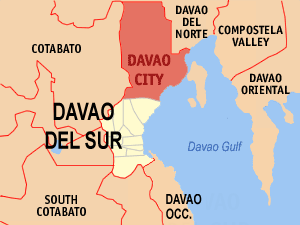Eden Nature Park and Resort
Eden Nature Park and Resort in Toril, Davao City
In 2007, I brought along a long-time friend and trusted associate, Tom Hilado of Manila for a month-long vacation with my wife, Grace, and daughter, Jamie in Davao City. Tom is one of those adventurous types of a guy who simply wonders aimlessly about in a totally unfamiliar place, always ready to try out just about anything - from the local street food, to the most exotic delicacy; from a wholesome joint, to the not too naive cocktail bar; from a decent health spa, and, to his utter surprise and amazement, to a downtown massage parlor whose masseuse did not only know how to massage but instead offered a different kind of "service" . . . . Being a decent, and well-bred fellow my friend, Tom is, he quietly left the place in question, and immediately took one of the popular rides in the City called the "habal-habal", a two-wheeled motorcycle usually ridden way beyond its passenger capacity, (Habal-habal can unbelievably carry 5 to 6 passengers effortlessly, and can only be found, where else but, in the streets of the Philippines particularly in Mindanao), and in an effort to discover what Davao City can offer to this insatiable adventurer, Tom found himself at the very doorstep of Eden Nature Park and Resort in Toril, and spent the entire afternoon wandering about the resort. It was already past the hour of 8:00 o' clock in the evening when Tom came back home to our rented abode in Catalunan Grande, and, over dinner, vividly narrated in detail his adventure for the day. Apparently, Tom immediately fell in love with the resort the moment he set foot to Eden Nature Park, and has never lost that emotional grip since.
Wide pathway leading to the Resort
Today, in our usual weekend discussions and views of current events over one too many bottles of beer back at my residence in Manila, Tom would reminisce his fond escapade to the mountains of Eden Nature Park, and I, in turn, as a good friend to him, patiently bear his litany of superlatives about this paradise in the mountains of Davao City called Eden Nature Park and Resort up to the very last drop of beer. Naturally, Tom hopes to be back in Davao City in the not too distant future, on a sentimental journey to Eden Nature Park.
Dedication of this special post to my good friend, Tom Hilado, is therefore, in order.
Entrance to Eden Nature Park
Eden Nature Park and Resort is one of the most frequented destinations in Davao City by foreign tourists and local visitors alike. Right at the very foot of Mount Talomo in Davao City's District of Toril, the Resort is quietly nestled on a sprawling expanse of 80 hectares of terraces carved out of the mountain slope, about 2,650 feet above sea level, and where over a 100,000 fully-grown pine trees, and another 100,000 towering forest trees are spread all over the area, providing a safe sanctuary to wild birds nestled freely on its branches, and forming a huge canopy of leaves that serve as a protective cover to other trees and plants flourishing wildly into a secondary forest of flora and fauna.
Unknown to many, Eden Nature Park is 95% man-made resort. Discovered sometime in 1971, the resort was once a logged-over area covered only by a blanket of wild grass. Today, the Eden Nature Park and Resort has become a truly world class facility that offers personalized tours and services to its resort guests. It's modern facilities and amenities include a 62-room hotel replete with non-smoking areas, and beautifully furnished with writing desks, cable televisions, shower rooms, mini bars and kitchenettes; a souvenir shop, laundry services, dry cleaning, meeting facilities, and a restaurant. There are also leisure and sports facilities such as pool for kids, a kids' club, an outdoor pool, and many flower gardens.
Places of interests in Eden Nature Park and Resort include:
Day Tour Center
The Day Tour Center is the information central of the day's activities of the resort where guests register here for day packages, guided tours, or special day events.
Guided Shuttle Tour
The Resort offers a 45-minute guided shuttle tour for those who are eager to get a glimpse and a quick orientation of the Resort's endless attractions and amenities. Availability of the shuttle tour, however, comes on a first-come-first-served basis.
Map of Eden Nature Park
Eden Nature Park's signage
Souvenir Shop
The Souvenir Shop features a variety of native handicrafts, and trinkets made in Davao, as well as souvenir items that carry the Eden label. It is conveniently located just across the Day Tour Center.
Outside the Souvenir Shop
Inside the Souvenir Shop
On display are the many native handicrafts and trinkets made in Davao
as well as souvenir items that carry the Eden label
St. Michael, The Archangel Chapel
St. Michael, The Archangel Chapel is located near the entrance of the Resort, and is a popular venue for weddings.
Inside the Chapel
The Amphitheater
The Amphitheater is a multi-function open area of manicured grass, perfect for mass, garden weddings, parties, and other social, and business events. It provides magnificent panoramic view of Davao City, and the Gulf of Davao.
The Amphitheater with Jade vine covering the columns
Breathtaking view of Davao City and the Gulf of Davao
Breathtaking view of Davao City and the Gulf of Davao
Garden of Eden with the Statue of St. Francis of Assisi
The Garden of Eden is a perfect place for prayer, or simply to wander about in the Garden with its cool and tranquil ambiance amid a rich variety of colorful plants beautifully arranged.
Entrance to the Prayer Garden
Wide pathways
Mountain Trail
This is one site in Eden Park where brisk walkers, hikers, and joggers enjoy nature's richness and the rejuvenating air filled with the whiff of towering pine trees as they ramble through the magnificent ravine trails and wide boulder pathways, while listening to the chirping of wild birds, and the rustling of leaves of pine trees and forest trees.
Wide pathways
Rainbow Pass
Man-made Matino Waterfalls
Vista Playground
Adventure ride called Indiana Jones
Eden Park's Zipline
Mayumi's Wishing Well
Mayumi's Wishing Well is filled to the brim with floating hibiscus in colorful array.
A closer look of floating hibiscus in colorful array
Lola's Garden
Lola's Garden is one of the beautiful spots in the Garden, and is frequented by guests for photo shoots. Various herbs and vegetables are organically grown here.
Various herbs and vegetables are organically grown
at the Lola's Garden
Eden Orchard
Eden Orchard houses rows of lettuces grown in hydroponics - a method of growing plants in nutrient-enriched water instead of soil, and is 100% pesticide free.
Hydroponics Garden
Eden Fishing Village
Tilapia and Hito are a day's prized catch in the Fishing Village.
Welcome signage to the Fishing Village
Pool of waters
Manicured grass in the Garden












































